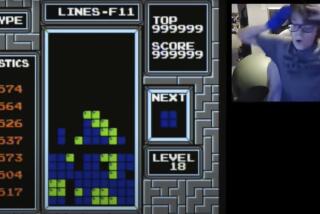‘Adventure,’ Other Classics Are Simply Enchanting
- Share via
These days, the classic 1981 game “Adventure” seems about as primitive as the telegraph or the typewriter.
No graphics. No sound. Just a bunch of black-and-white text describing an enchanted series of caves inhabited by elves, dragons and pirates. Players maneuvered from cavern to cavern with simple typed commands--”W” to go west, “S” to south, “SW” to go southwest--and spent as much time sketching their progress in notebooks as they did working on the computer.
But two decades ago, “Adventure” was one of the first wow-games for the new IBM PC. It allowed players to communicate in basic English commands such as “free bird,” “kill dragon” and “get rug.” And, although versions of the game had been kicking around mainframe computers for years, its debut as “Microsoft Adventure” on the PC gave average consumers a taste of just how powerful video games could be.
What a long way we’ve come since then.
But not really.
In many ways, those early days of gaming demanded far more imagination and creativity than the modern age of thousands of colors and smoothly textured polygons.
“Adventure”--versions of which can be downloaded from the Internet--required players to pay attention, to think and to imagine themselves in the magical caves. The text descriptions provided a context and the barest of details. Players filled in the rest as they did with classics such as “Zork” or the Douglas Adams series of text-based adventures.
The era between the mid-1970s and the mid-1980s witnessed perhaps the most dramatic transformation in video games as designers and programmers in an infant industry created franchises from thin air. The fundamental genres that game players enjoy today--from shooters to adventures to racers to puzzlers--were born in this period.
Unable to hide behind dazzling graphics and supercharged sound, the games had to deliver visceral play that was easy to learn, tough to master and impossible to walk away from. “King’s Quest” introduced strong graphic adventures--and in some ways ushered in the modern era of gaming--but it was built on the foundations of rudimentary games.
Because early computing was a hobbyist endeavor, it was possible to literally rip apart games and customize them--a feature that is again possible in limited ways with level editing tools. But in those early days, a home user could copy code from a computer magazine and tweak it to their personal tastes.
What evolved was a culture of gamers who often designed their own games. For instance, I would snitch machine language subroutines to power the joystick of my Commodore and then write games in BASIC. They were slow and kludgey, but they worked--and sometimes looked better than the games we played on our Atari 2600.
Maybe you had to be there, but it’s impossible to overstate how remarkable “Pong” was in 1972. The game remains wonderfully simple and addictive. Versions of it also can be downloaded onto a PC.
The same goes for old coin-op titles such as “Breakout,” “Tempest” and “Donkey Kong,” all of which are archived in various forms online. The “Mame” emulator allows players to download the original coding for many arcade games of the era, allowing players who don’t remember a president before Ronald Reagan to get a sense of why these games remain classics.
“Tempest,” for instance, has a learning curve of about 15 seconds. Players dance across the top of a grid crawling with vector-graphics baddies. Simple, elegant and utterly compelling.
“Breakout,” which debuted in arcades in 1976 and on Atari 2600 two years later, offered a rudimentary challenge of knocking out colored bricks with a bouncing ball. Even my grandmother was hooked on the Atari 2600 version.
So enduring are games from this era that they have been knocked off again and again--often with disappointing results. Simplicity defined games such as “Centipede” or “Pac Man.” Dolling them up with three-dimensional graphics often does little to improve them.
When, for instance, Hasbro Interactive tried to update “Breakout” on Sony PlayStation, the result was a bloated mess of a game.
Notable exceptions include some of Activision’s efforts with titles such as “Asteroids” and “Space Invaders” for Sony PlayStation or Nintendo Game Boy Color. Updated versions of “Missile Command” and “Tempest” for the ill-fated Atari Jaguar also offered some fun.
It’s telling that the only Game Boy cartridges I tote around when I travel are updates of games from the early 1980s. They’re simply more fun and more engaging than many of the overproduced titles released today.
As good as some modern games are, most devote more attention to overwhelming players with sound and color than they do knocking them out with stellar, imaginative game play. Scrounge up a copy of “Adventure” and see what I mean. Two decades later, it holds up. Let’s see whether “Diablo” does in 2021.
*
Aaron Curtiss is editor of Tech Times.
More to Read
The biggest entertainment stories
Get our big stories about Hollywood, film, television, music, arts, culture and more right in your inbox as soon as they publish.
You may occasionally receive promotional content from the Los Angeles Times.










